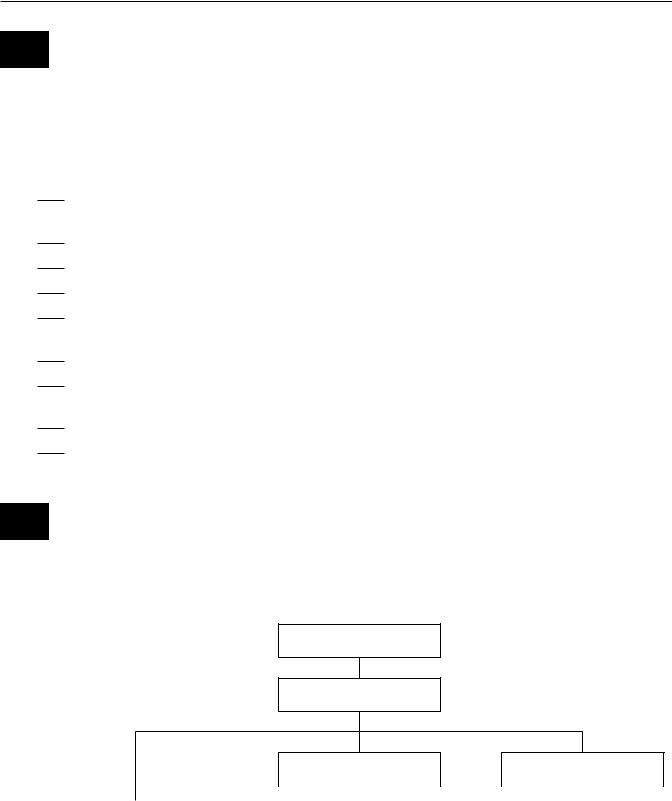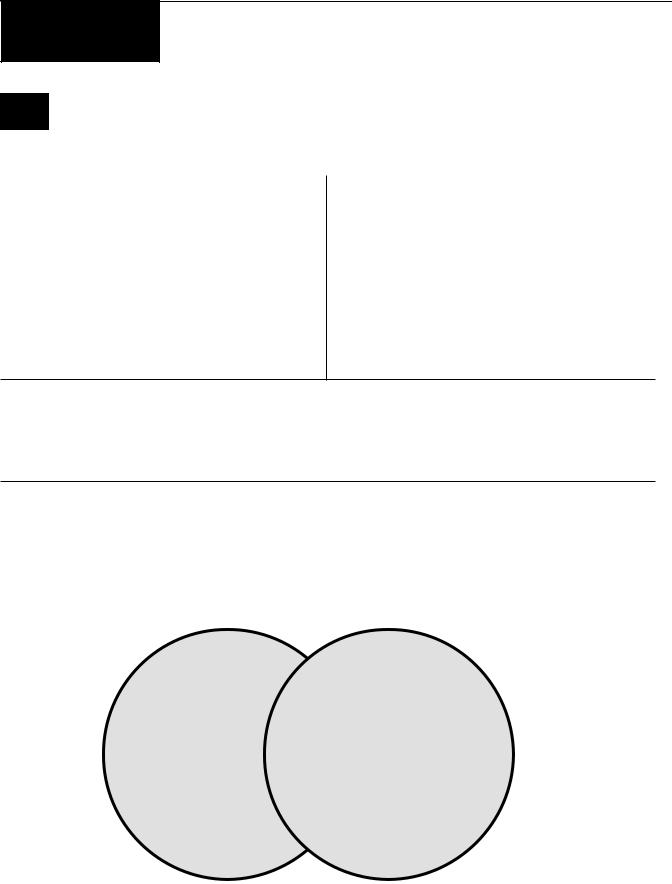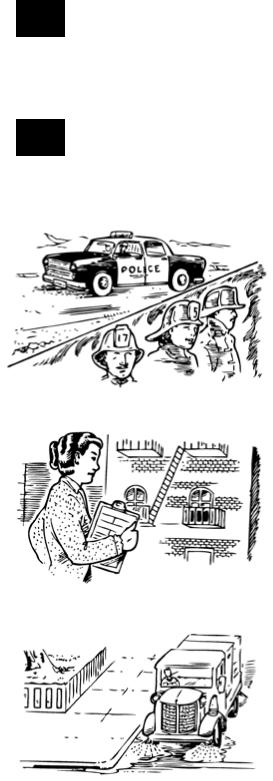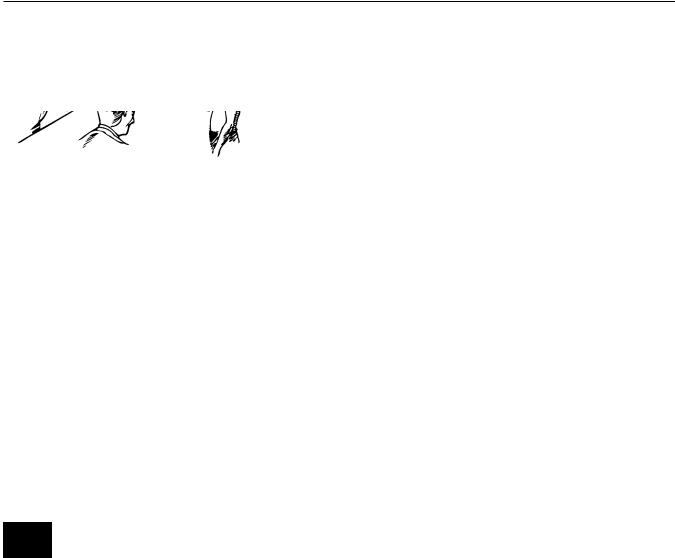
about_the_usa
.pdf
102 Module 7A / Branches of Government and Officials
C Work in pairs. Tell your partner each fact about state government and listen to the corresponding fact about the federal government. Write S on the line if the facts are the same for both governments. Write D if they are different.
1. |
S |
State government is in the form of a democratic republic, which means that the people |
|
|
elect representatives. |
2.In addition to power through their elected state representatives, the people have direct power through the initiative, referendum, and recall processes.
3.The government follows the principles of a constitution with its bill of rights.
4.The government has three branches with different responsibilities and powers.
5.The legislative branch has two houses that make laws.*
6.The upper house is a senate, and the lower house is a state assembly or a house of representatives.
7.The leaders of the executive branch are the governor and the lieutenant governor.
8.The executive branch includes advisors to the governor. Some advisors are elected and some are appointed.
9.The judicial branch of state government judges cases of state law.
10.The highest court is the state supreme court. There may also be appellate (appeals), county, superior, district, circuit, municipal, and special courts.
D From the information in C on this page, write the missing words in the boxes.
State Constitution
State Government
Executive
|
|
|
|
|
|
|
|
|
|
|
|
|
|
|
|
|
|
|
|
|
|
|
|
|
|
|
|
|
|
|
|
|
|
|
|
|
|
|
|
|
|
|
|
|
senate |
|
|
|
|
advisors |
|
|
|
|
|
other levels of courts |
|||
|
|
|
|
|
|
|
|
|
|
|
|
|
|
|
* Only Nebraska has a one-house state legislature.

UNIT 7 / State Government 103
E Make sentences about the similarities and differences in federal and state government with these sentence patterns.
EXAMPLES: 1. Both the federal and state governments are in the form of a republic. In both the federal and state governments, the people elect representatives.
2.Both the federal and state governments are representative democracies because the people elect representatives. On the other hand, in state government, the people also have direct power in law making.
1. |
(In) Both the federal and state governments |
|
. |
. |
|||
2. |
(In) The federal government |
|
|
|
|
||
|
On the other hand, (in) state government |
|
|
. |
|
||
|
|
|
|
||||
F Read the information. Then find out the answers to the question about the executive branch of government in your state.
The chief executive of a state is the governor. A lieutenant governor replaces the governor if he or she can no longer serve. In some states, the governor appoints his or her advisors, and in other states, the people elect them. High state officials may have different titles, but their responsibilities are similar in all states. For example, the Secretary of State keeps records and announces new laws. The Attorney General represents the state in court. The Treasurer receives tax money and pays bills for the state, and the Auditor or Comptroller is concerned with state financial matters. The Superintendant of Public Instruction is the highest officer in educational matters.
1.Who is the head of the government?
2.Who announces new laws?
3.Who is responsible for educational concerns?
4.Who pays the bills for the state?

104 Module 7B / Functions, Powers, and Services
Module 7B: Functions, Powers, and Services
A Work in pairs. Look only at this page and answer your partner’s questions about the responsibilities of the federal and state governments.
Only the federal government:
•declares war
•supports the armed forces
•coins money
•establishes and maintains post offices
•gives authors and inventors the exclusive right to their work (copyrights or patents)
•makes treaties with the governments of other countries
Only a state government:
•maintains a police force
•supports a state militia, such as the National Guard
•regulates transportation and trade within the state
•establishes and maintains schools
•oversees local governments and grants city charters
Both the federal and state governments:
•fund public projects (buildings, dams, highways, etc.)
•support farming and business
•maintain court systems
•regulate banks
The federal government usually provides funding and the states distribute the money and provide programs for:
•public assistance for people in need
•health care
•protection of natural resources
•improvements in living and working conditions
powers of the |
shared |
powers of |
|
Federal |
State |
||
powers |
|||
Government |
Government |
||
|
“The powers not delegated to the United States by the Constitution nor prohibited by it to the states are reserved to the states respectively, or to the people.” The Tenth Amendment to the Constitution of the United States.

UNIT 7 / State Government 105
B Work in pairs. Look only at this page and ask your partners questions with the pattern “Which government …s …?” Write the answer or answers on the line.
EXAMPLE: |
Student 1: |
Which government declares war and makes treaties? |
|
Student 2: |
The federal government. |
1. … declares war and makes treaties?
federal
2.… maintains a police force and state militia?
3.… regulates trade and transportation in the state?
4.… coins money and maintains post offices?
5.… establishes and maintains schools?
6.… regulates banks and supports business?
7.… oversees local government and grants city charters?
8.… funds public projects, like dams and highways?
9.… maintains court systems?
10.… issues copyrights and patents?
11.… provides public assistance and health care for people in need?
12.… provides funding for the protection of natural resources?
13.… distributes money through programs to improve living and working conditions?
C Answer these questions in as many ways as you can.
1.What can the federal government do that a state government can’t? (Example: declare war)
2.What does a state do that the federal government doesn’t do?
3.What do both the federal and state governments do?
4.What programs does the federal government provide funding for and state governments maintain?

106 Module 7B / Functions, Powers, and Services
D The Separation of Powers in State Government
State governments are similar in structure to each other and to the federal government. Under the principle of separation of powers, the government of each state has three branches—the legislative, the executive, and the judicial. In the system of checks and balances, each branch has some control over the other two branches.
The governor may veto bills from the legislature (the senate and the house or assembly). In some states, the governor uses a “line-item veto.” This way, he or she does not have to reject an entire law in order to veto parts of it. The governor also appoints judges in the judicial branch. With enough votes in both houses, the legislature can override the governor’s veto.
Like the federal courts, state courts also explain and interpret laws. They can declare state laws unconstitutional (contradictory to the state constitution).
State government includes a system of direct democracy. Through the initiative process, citizens may put proposed laws on the ballot for the people to vote on. They may decide on proposed constitutional amendments or important state issues in a referendum. Through a recall, they can sometimes remove an elected government official from office.
The federal government also has power over state governments. For example, a state constitution or court may not contradict the U.S. Constitution, and the U.S. Supreme Court may overrule the decision of a state supreme court. Also, the U.S. President may withhold money from a state if the state refuses to obey federal laws.
E Write T for true and F for false. Correct the false sentences.
1.All state governments are similar to one another, but they are different in structure from the federal government.
2.The principles of separation of powers and checks and balances apply to state as well as the federal government.
3.In a “line-item veto,” the governor can reject parts of initiatives, referendums, or recalls.
4.Like in the federal government, state legislatures can override vetos, and state courts can declare laws unconstitutional.
5.Citizens may propose laws, vote on constitutional amendments, and recall elected officials in the federal system of direct democracy but not in a state system.
6.The U.S. Supreme Court and the U.S. President have some direct power over state governments.

|
|
|
8 |
||
Local Government |
UNIT |
||||
|
|
||||
|
|
|
|||
|
|
|
|
|
|
Module 8A: |
County and City Services |
|
|
|
|
|
|
|
|
|
|
A Public Services
The names of the departments of county or city government may vary. However, in both large cities and small towns, these departments provide similar services to the public.
B Work in groups of five. Each of you studies the information in a different section. In turn, summarize the information in your own words for the group.
In some cities, there are separate police and fire departments. But in other places, the Department of Public Safety includes a police bureau and a fire bureau.
In the police bureau, there may be a separate traffic division responsible for accident investigation, a detective division to examine the evidence in crimes, and an identification and laboratory section. Volunteer companies may fight fires in the county and in small towns, but the fire bureau of a city is a large professional unit.
The Department of Public Safety may include a building inspector and a traffic engineer. The office of the building inspector issues construction permits to contractors. It sends out employees to inspect new and old buildings. These officials check for violations of the building code, the local rules for safety.
Employees of the city’s traffic engineering bureau study traffic patterns and recommend places for one-way streets, traffic lights, stop signs, and so on.
The Public Works Department is responsible for the maintenance of streets and sewers (pipes that carry wastes). Its employees clean the streets and collect garbage. Most cities hire private contractors for major construction projects and repairs.
107

108 Module 8A / County and City Services
The Department of Public Utilities usually provides water, gas, and electricity, and in some places, it runs transportation lines. It also operates water purification plants. Employees of the department read the utility meters on each building to determine monthly billing.
|
The Department of Public Health sends inspectors out to |
|
restaurants, food-processing plants, nursing homes, and |
|
similar places. If a place has violated local health or |
|
sanitation laws, the department issues warnings and |
|
instructions. It can impose penalties if violations are not |
|
corrected. |
|
Other divisions of the health department run clinics that |
|
provide low-income people with free health services, such as |
|
chest X-rays, lab tests, and baby care. They may also offer |
|
health education. |
5. |
The Department of Social Services is concerned with the |
|
welfare of people who need help, such as young children, the |
|
disabled, the elderly, and the blind. Most of the money for |
|
these programs comes from state and federal tax funds. |
|
The Department of Parks and Recreation maintains parks |
|
and other recreational facilities, such as community centers, |
|
swimming pools, tennis courts, and baseball fields. It may |
|
also provide recreational programs (instruction in sports, |
|
dances, classes, etc.). |
C Correct these false sentences.
1.The services of local government departments differ from one city to another, but the names are always the same.
2.The Department of Public Safety may include social services and health inspection.
3.Volunteers run the fire departments or bureaus of large cities.
4.Most cities hire private contractors for minor maintenance of streets and sewers and for garbage collection.
5.The Department of Public Health has no power because it can’t impose penalties for violations of sanitation laws.
6.The disabled, the elderly, and the blind provide funding for the programs of the Department of Social Services.

UNIT 8 / Local Government 109
D Work in pairs. Ask and answer questions about public services with these sentence patterns.
EXAMPLE: |
Student 1: |
What does the traffic division of the police department do? |
||||||
|
|
|
Student 2: It investigates accidents. |
|||||
|
|
|
|
|
|
|
|
|
1. |
What |
|
does |
|
|
|
usually do? |
|
|
|
|
do |
|
|
(department, division, or people) |
||
|
|
|
|
|
|
|
||
. |
It |
|
|
|
|
|
|
. |
|
hey |
|
|
|
|
(description of service) |
||
E What Can You Learn at City Hall?
Many cities offer guided tours of their seat of government, usually the city or town hall. You to can also visit the local departments on your own to find out what they do. Here are some examples of questions you might ask.
The Finance Department |
The Commerce Department |
1.How much does it cost to run the city?
2.How does the city spend its money?
3.Where does the money come from?
4.How does the city borrow money?
The Law Department
1.What legal services does the city need?
2.In what situations must the city go to court?
3.What records does the city keep?
4.Can citizens sue the city? (If so, how?)
Transportation Department
1.What public transportation does the city provide?
2.Where does the city get transportation equipment?
3.How does the city plan its systems?
4.How does it get funding for those systems?
1.How does the city attract new businesses?
2.What does the city offer visitors and tourists?
3.What public information services does the city offer?
4.How does the city “compete” with other cities?
The City Planning Department
1.How does the city plan its growth?
2.What is zoning, and how does the city use it?
3.What does the city require from private developers?
4.What is the “Master Plan” of the city?
Personnel Department
1.How many employees work for the city?
2.How did they get their jobs?
3.What is the Civil Service system?
4.What is the salary range for city jobs?

110 Module 8A / County and City Services
F As a class or in small groups, visit city hall or the seat of government in your town or county. Complete one or more of these activities and report on your experience to the class.
1.List the names of the city departments. Circle the departments with the same names as the departments mentioned in this module.
2.Choose one or more of the departments discussed in Exercise B. List at least four questions about it, similar to the questions in E. Visit the department and ask an employee the questions. If you think of more questions, ask them. Take notes on the answers. Summarize the information in a short report.
3.Choose one or more of the departments in E. Visit the department and ask an employee the questions. When he or she gives an interesting answer, ask more questions about that topic. Take notes and summarize the information in a short report.
4.Follow the instructions in (2) for another government department.

UNIT 8 / Local Government 111
Module 8B: County Government
A The Structure of County Government
County government is different in structure from state and federal government. The elected governing body has many different names throughout the country, but “board of supervisors” and “board of county commissioners” are two common ones.
A county board receives its authority from the county charter (official document to establish an organization). It not only passes ordinances (county laws), but it enforces them, too, along with state laws. The board may share executive powers with other elected officials such as the sheriff. County revenue comes from the federal and state governments, county property taxes, and other sources such as sales and income taxes and licensing.
A small county board has between five and eleven elected members, usually part-time officials. They meet in the county seat, a city or town in the county.
B Here is some information about state government. Finish each sentence with the corresponding information about county government.
1. The elected governing body of the state is the state legislature, but the elected governing body of the county has many different names, such as “board of supervisors” .
2. The state government receives its authority from the state constitution, but the county board
.
3. The state legislature passes state laws, but the county board
.
4. The governor is the chief executive of the state, but the county board
.
5. State revenue comes from state taxes, but county revenue
.
6. The state legislature has hundreds of members, but a county board
.
7. State legislators usually meet in the state capital, but county board members
.
